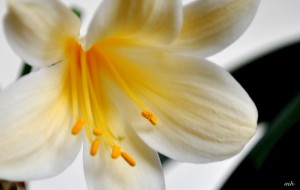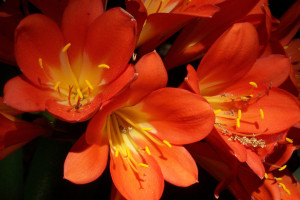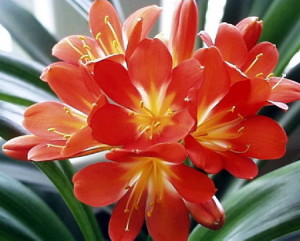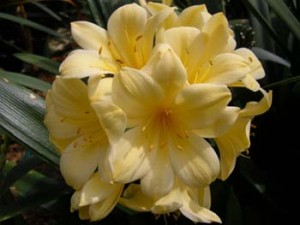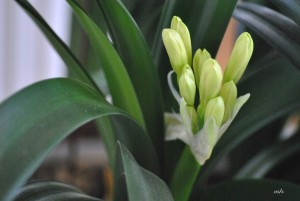Recent Pages: 1 2 3 4 6 7 8 9 10 10b 10c 11 13 15 16 17 18
18a 19 20 21 22 23 24 25 26 26a 27 28 29 30 31 32 33 34 35 41 42 43 44 45 46 47 48 48a 49 50
Lan quân tử
Lan quân tử hay còn được gọi là cây đại quân tử có tên tiếng Anh là Clivia (Clivea). Lan quân tử không thuộc vào nhóm các cây Lan (Orchid) mà lại thuộc giống lilies, đặc biệt rất gần với African Lily (Agapanthus). Loại này đẹp cả hoa lẫn lá.
Cây Lan quân tử là loài cây cứng cáp và mạnh mẻ. Trong quan niệm của người Trung Quốc cây Lan quân tử là biểu tượng của thịnh vượng và tài khí. Hoa và lá của Lan quân tử có sức sống khá bền, thời gian tươi rất lâu, tượng trưng cho sự phú quý lâu dài.
Theo quan niệm trong phong thủy cây Lan quân tử hoa màu vàng có thể phân biệt được âm dương và phân biệt được tư tưởng của con người. Khi gia trung bất hòa hoặc đang ở trong vận hạn cây sẽ không nở hoa. Còn khi sắp có niềm vui cây liền trổ hoa báo trước, đó tức là “Báo Hỷ Hoa”.
Thực ra lan quân tử không phải thuộc họ lan mà thuộc họ hành tỏi nên có tên khoa học là Cliva nobilis Lindl. Lan quân tử là cây thân cỏ sống nhiều năm, chất thịt, chất thô, thân chia củ và vẩy giả. Lá hình kiếm, mọc lệch dài 30-50cm.
Đặc điểm cây đại quân tử: là cây thân thảo, thường xanh. Lá cây màu xanh mướt, mặt lá bóng. Hoa có hình chuông, khoảng 12-18 hoa chụm lại làm thành 1 chùm và mỗi cây trung bình có được 2-3 chùm hoa. Tất cả nằm chen giữa đám lá xanh bóng bẩy, rực rỡ nhưng không lồ lộ. Phải nói đây là một loài hoa đẹp thanh nhã và cuốn hút.
Hoa Lan Quân Tử nở đỏ cam rực rỡ từng chùm như thể hiện cho sự sung túc và may mắn.
Lan quân tử là một loài hoa nguyên sản ở châu Phi du nhập vào Trung Quốc hơn 100 năm, thế hoa mềm mại, hoa đẹp, lá xanh tựa bích ngọc, được mọi người ưa thích. Lan quân tử được trồng có 2 loại: lan quân tử lá hẹp và lan quân tử hoa lớn. Lan có giá trị thưởng thức rất cao. Lan quân tử có rễ chất thịt, trong rễ có chứa một lượng nước nhất định, cho nên chúng có khả năng chịu hạn.
Tuy nhiên mùa hè không khí khô vẫn không nên quên tưới nước. Khi tưới nước cần chú ý căn cứ vào tình hình khô của chậu nhưng lượng tưới không nên nhiều để giữ cho chậu ẩm vừa.
Nói chung, mùa xuân mỗi ngày cần tưới 1 lần, mùa hè dùng vòi phun phun lên mặt lá và xung quanh, mỗi ngày phun 2 lần. Mùa thu cách 1 ngày tưới một lần, mùa đông mỗi tuần tưới một lần. Nhưng cần chú ý phải nắm vững các tình hình cụ thể khác nhau. Nếu trời nắng phun nhiều, trời râm phun ít, mưa thì không tưới. Khi nhiệt độ cao, không khí khô thì một ngày cần tưới nhiều lần. Nếu có điều kiện phải dùng nước mềm để tưới như nước mưa, nước sông, sau đó là nước ao, hồ, kém nhất là dùng nước máy. Có thể dùng thùng, chậu đựng nước máy để sau 2-3 ngày tưới. Như vậy để các chất có hại lắng đọng, cũng có thể để cho các chất trong nước oxy hoá làm sạch làm cho nhiệt độ nước gần với nhiệt độ của chậu.
Cây hoa thường rất ưa phân bón nhưng cũng phải có mức độ, nếu bón quá nhiều gây khô héo, thối rễ. Sinh trưởng, phát triển ở các giai đoạn khác nhau thì nhu cầu dinh dưỡng khác nhau cho nên cần áp dụng phương pháp bón phân thích hợp như bón lót, bón thúc, bón ngoài rễ.
Bón lót: Mục đích của bón lót là tạo điều kiện sinh trưởng, phát triển thoả mãn dinh dưỡng cho cây. Bón lót với lan quân tử tiến hành lúc thay chậu 2 năm một lần, phân bón lót thường dùng phân chuồng, phân xanh, phân bã đậu.
Bón thúc: Chủ yếu là xúc tiến sinh trưởng, bón thúc với lan quân tử thường dùng bột cá, bột xương. Khi mới trồng chỉ bón ít, về sau khi lá to thì tăng dần lượng bón phân. Khi bón thường sâu 2-3cm, nhưng cần chú ý không bón gần bộ rễ. Đối với phân thể rắn thường mỗi tháng một lần. Bón phân thể lỏng thường phải ngâm phân hoai trong nước 30-40 lần đối với cây con, 20 lần đối với cây lớn. Sau khi tưới nước để phân thấm vào bộ rễ, phát huy hiệu quả của phân. Trước khi tưới 1-2 ngày, không nên tưới nước. Thời gian bón phân thường vào buổi sáng. Khi tưới cần tưới vào quanh chậu, chú ý tránh tưới vào lá, vào cây. Ngoài ra thời gian bón phân cũng khác nhau, màu xuân và mùa đông nên tưới P và K như là bột cá, bột xương, mùa thu bón một số dịch thấm của lông động vật, sừng, chân động vật hoai, pha loãng 30-40 lần.
.
Thay chậu và nhân giống hữu tính Lan quân tử
Lan quân tử sau khi trồng 2 năm phải thay chậu bởi vì khi cây lớn lên chậu con không thích ứng, dinh dưỡng trong đất bị hấp thu khá nhiều, sâu bệnh hai có thể nhiễm vào bộ rễ. Thời gian thay chậu vào mùa xuân (trước Cốc vũ) và mùa thu khi nhiệt độ khoảng 20oC là thích hợp nhất. Trong đất dinh dưỡng nên thêm một ít bột xương hoặc Ca3(PO4)2. Khi thay chậu trước hết dùng dao vạch xung quanh chậu. Sau đấy dùng tay đỡ giữ cổ rễ và lật chậu đổ cây ra rồi đưa vào chậu khác. Khi trồng cây phải để vào giữa chậu, cắt bớt rễ quá dài, lắc chậu để rễ tiếp xúc với đất, tưới đều 1 lần nước.
Dùng phương pháp gieo hạt để nhân giống lan quân tử. Phương pháp này dùng khá phổ biến, ưu điêm của phương pháp này là có thể nhân giống hàng loạt, nhưng trước hết phải sử dụng thụ phấn nhân tạo, tốt nhất là thụ phấn khác gốc. Vì thụ phấn khác gốc tỷ lệ kết hạt cao hơn thụ phấn cùng gốc rất nhiều.
Phương pháp thụ phấn: sau khi hoa nở 2-3 ngày, bao hoa thành thục, nhuỵ hoa tiết chất nhầy là lúc thụ phấn tốt nhất. Khi thụ phấn dùng bút lông quét hết phấn trên nhị, để phấn rơi vào đầu nhuỵ. Muốn tỷ lệ kết hạt cao thường tiến hành vào 9-10 giờ sáng và 2-3 giờ chiều. Sau 8-9 tháng quả chín biến thành màu tím đen là có thể thu hái quả, sau 10-20 ngày bóc vỏ quả lấy hạt. Trước lúc gieo hạt ngâm vào nước ấm 30-35oC sau 20-30 phút, vớt ra rửa sạch gieo vào đất chậu để trong nhiệt độ 20-25oC, độ ẩm 90%, sau 1- 2 tuần hình thành rễ phôi.
.
Chơi “Lan Quân Tử” – Tạo Phong Thủy Cát Tường
Quân Tử Lan có thể phân biệt Âm Dương. Cây thuộc vào loại ưa Dương, bởi vậy khi bố trí tại các vị trí ẩm thấp, tối, cây sẽ phát triển yếu ớt, không ra hoa. Nhà nào thiếu Dương Khí khi bày Quân Tử Lan sẽ có phản ứng. Căn cứ theo đó có thể cải tạo để nạp thêm ánh sáng mặt trời, tạo ra Dương Khí. Quân Tử Lan thuộc vào Ngũ hành Mộc Khí rất ứng hợp với người mệnh nạp âm là Mộc (tuy nhiên các tuổi khác vẫn tốt, nhưng tuổi Mộc có thể dùng riêng cho mình) không chỉ dùng trang trí cho đẹp, mà còn phát huy tác dụng Phong Thủy để hỗ trợ tài vận, hảo vậnTrồng cây, chăm cây, bố trí cây ở tại gia cư chứng thực là có tác dụng về Phong Thủy Học. Mỗi loại cây đều có một hoặc vài tác dụng về Phong Thủy khi được bố trí đúng cách. Tuy nhiên riêng có một loại cây lại có được những điểm đặc biệt độc đáo về Phong Thủy. Đó là “Quân Tử Lan”.
Quân Tử Lan có thể cảm nhận được tư tưởng của người sống ở trong nhà, khi gia trung bất hòa hoặc đang ở trong vận hạn cây sẽ không nở hoa. Còn khi sắp có niềm vui cây liền trổ hoa báo trước, đó tức là “Báo Hỷ Hoa”.
Hoa Lan nói chung và Quân Tử Lan nói riêng được coi là loài hoa vương giả mang đến cho người trồng nó sự phú quý, tuy phần chăm sóc cũng khá tỷ mỷ nhưng cái đem đến cũng rất tốt. Ngày Tết đầu năm bày được một chậu Lan đẹp, cũng như lời nguyện ước một năm Phú Quý bền vững.
Phương Pháp Bài Trí Lan Quân Tử Phát Huy Cát Tường:
1. Bố trí ở cửa trước, biểu thị cho phong cách Quân Tử của Chủ Nhân. Hoa tức là lời tín nhiệm muốn ngỏ của Chủ Nhân với mọi người vậy.
.
2. Bày ở phòng đọc sách, như một lời tự nhắc nhở phải luôn sống và làm đúng một người Quân Tử. Thư Phòng, phòng làm việc là nơi chúng ta ngồi học, làm công tác hằng ngày, Quân Tử Lan tượng trưng cho phương hướng phải đi.
.
3. Nếu Bàn làm việc rộng có thể bày ngay trên bàn, bên tay trái của chủ nhân khi ngồi làm việc. Vượng Thanh Long tất có quý nhân phù trợ.
Nguồn: phongthuycom vn
Clivia
 .
.
Clivia miniata, flowers are one of the best antidotes to the icy winds of winter, and growing a houseplant that buds and blooms inside while all is dormant outside is particularly satisfying. This winter, as an alternative to the brightly blooming azaleas, chrysanthemums, or traditional holiday plants, consider growing a clivia plant.
Clivia miniata is a wonderful flowering plant. Elegant and imposing, it’s easier to grow than an orchid and more unusual than an amaryllis or a Christmas cactus. When given a month of cool night temperatures in autumn, followed by a six-to-eight-week rest period with very little water, a clivia plant will produce dense clusters of orange, lilylike flowers. Equally important, the straplike, dark evergreen leaves are virtually blemish free, making clivia an attractive foliage plant, even when not in bloom.
CLIVIA FLOWERS
 Clivia belongs to the lily family (Liliaceae), the same family as amaryllis, and it’s easy to see why. Each colorful clivia flower is similar in shape to, but much smaller than, the larger trumpet-shaped amaryllis flower. Clivia flowers cluster together to form large conspicuous flower heads. There is some variation in height within the species, with certain clivias sending up 20-inch stems with flowers on top and others with flowers close to the center of the plant, nestled within the foliage. In either case, the flowers are sufficiently showy to brighten all winter windows. The primary flower color is orange, but there are also highly prized yellow-flowered cultivars that are rare and quite expensive.
Clivia belongs to the lily family (Liliaceae), the same family as amaryllis, and it’s easy to see why. Each colorful clivia flower is similar in shape to, but much smaller than, the larger trumpet-shaped amaryllis flower. Clivia flowers cluster together to form large conspicuous flower heads. There is some variation in height within the species, with certain clivias sending up 20-inch stems with flowers on top and others with flowers close to the center of the plant, nestled within the foliage. In either case, the flowers are sufficiently showy to brighten all winter windows. The primary flower color is orange, but there are also highly prized yellow-flowered cultivars that are rare and quite expensive.
Clivias are large, heavy plants. A mature plant can be 2 to 3 feet tall and almost as wide, with long, arching swordlike leaves. It requires a large, wide-based, clay pot that won’t tip over. Like many flowering plants, clivia prefers to be kept rootbound and can remain in the same pot for as long as five years. Since it takes a few years for a clivia plant to bloom, it’s best to purchase a mature plant, unless you are very patient.
DIFFICULT TO PROPAGATE
Dr. Jim Ault, director of Ornamental Plant Research at the Chicago Botanic Garden, explains that clivias are slow-growing and difficult to propagate. “If you grow clivias from seed, it takes three to five years for them to bloom for the first time,” he says. “The big, marvelous plants you see that fill a whole container take five to 10 years or more to reach that size.”
Compounding the difficulty of propagating clivias is the fact that they cannot be tissue-cultured, Dr. Ault says. Tissue culture, a laboratory technique used to propagate plants, allows commercial growers to produce hundreds of plants from a single bud or even cell, knowing that each new plant will be an exact duplicate of the parent. This is especially important in the development of plant cultivars that are typically selected for specific ornamental characteristics. Unfortunately, clivias, like other plants resistant to tissue culture, can be propagated only from seeds or division.
IN THE WILD
According to Dr. Ault, clivias are native to the subtropical forests of eastern South Africa where he has seen them growing wild. “You’ll find them growing in very organic material, in deep to partial shade, sometimes on top of rotting logs,” he said. He has also seen a rare, yellow-flowered clivia growing wild in South Africa.
There also exists in cultivation an extremely rare clivia with a variegated leaf. “I have seen it once,” said Dr. Ault. The plant belonged to a colleague and “it was very bashful about making offsets, very slow in making new plants.” His colleague had owned it for many years and was still unable to propagate it.
CLIVIA CARE IN SPRING AND SUMMER
Given the regal quality of the plant, a clivia is surprisingly easy to grow. It is well suited to a bright north window, or an east or west window shaded from the sun. It does not need high humidity and should not be misted. During the spring and summer growing seasons, a clivia needs regular watering but should be allowed to become dry to the touch between waterings. An automatic weekly watering will often be too much and can cause rot. Fertilize once a month with a half-strength dilute solution of 20-20-20 fertilizer. While rarely in need of repotting, plants can be divided and repotted almost any time of the year. Simply cut or pull the large fans of leaves apart, ensuring each division has a plentiful supply of the large fleshy roots, and pot up in a well-drained organic soil mix.
CLIVIA CARE IN FALL AND WINTER
In the fall, the clivia’s schedule is similar to that of a Christmas cactus. Stop fertilizing; water only when the foliage begins to wilt; and place the plant in a porch or other cool room where night temperatures drop below 50 degrees. This six- to eight-week rest period is essential for flower bud formation. A shorter cool period could result in delayed flowering. Once inside, water very sparingly until flower buds appear nestled between the leaves. This might take two months but will reward you with a spectacular bloom just as winter enters its bleakest stage. When flowers fade, remove the stalk at its base to prevent seed set. In spring, resume normal watering and feeding
AT THE GARDEN
If you visit the Greenhouses at the Chicago Botanic Garden in late winter, you can see both the yellow and orange clivias. But you don’t need a greenhouse to grow them — they’re unusual and satisfying houseplants for almost any home.
Soure: Chicago Botanic Garden
Growing Clivia miniata
Clivias have a well-earned reputation as rugged houseplants that demand very little attention.
LIGHT: Clivias grow best where they receive bright daylight but little or no direct sun–in a north-facing window, for example, or in an east- or west-facing window that is partially shaded by a deciduous tree. You can summer your plant outdoors in a shady location. Just remember to bring it back in before the first frost. Clivias won’t endure temperatures that dip much below freezing.
WATER: During the growing season, which begins after the “Winter Rest” and continues through October, water thoroughly (until water drains freely from the hole in the bottom of the pot) when the top inch of the potting mix becomes dry to the touch. Clivias prefer to be kept on the dry side. Potting mix that remains constantly wet can cause rot, which is first manifested by the appearance of pale green or bright orange cankers on the leaves. We strongly suggest that you avoid a weekly watering regimen and instead water only when the plant requires it. Please note that misting the leaves is neither necessary nor desirable and can encourage disease.
WINTER REST: Clivias flower more reliably if you give them a period of rest in late fall. Begin this rest period once your plant arrives, and repeat it every year thereafter. For 12-14 weeks (about 3 months), keep the plant in light in a cool room (50-65°F is ideal) and withhold water. Keep a close eye on your plant during this resting period. If you notice that it is beginning to wilt, add a scant 1-2 cups of water, just enough to moisten the soil lightly. Begin normal watering (see “Water” above) at the end of the “Winter Rest”. Bloom usually, but not always, follows in 6-12 weeks.
FERTILIZER: After your plant has bloomed (generally in the period from April to August), fertilize it monthly with a water-soluble fertilizer (20-20-20) mixed at ½ the recommended strength. Use restraint: More fertilizer is not better. Stop fertilizing by mid-September.
GROOMING: Cut flower stalks off at the base after the blooms have faded to prevent the plant from expending energy on the production of seeds. Also remove leaves that withered and turned brown.
REPOTTING: Clivias tolerate considerable crowding of their roots and bloom best, in fact, when pot-bound. As a plant grows, some of the fleshy roots may push their way up above the potting mix. This is normal. Repotting is necessary only every 3-5 years. After bloom, lift the plant from its pot and place it in a new pot that is no more than 2 inches in diameter larger than the old one. Use a potting mix that drains well and that is composed of at least 50% organic matter, such as peat moss or fir bark. Most potting mixes sold at garden centers meet both requirements.
Soure: White Flower Farm
How to Make Your Clivia a Blooming Winner
Here are some key conditions that are necessary to get your plant to bloom on time for the show next year, or just getting your plant to bloom in general:
- Provide optimal light conditions for the production of flower buds. Mike grows his plants outside for the summer in protected areas.
- While growing outside, Mike fertilizes every two weeks with half strength Miracle Gro 20-20-20.
- Before the first freeze, move your plants indoors.
- Plants should get no water between October 1 and January 22. It is critical that during this time the plants are chilled at temperatures between 35 and 55 degrees F for a minimum of 5 weeks to initiate bloom. If this cold treatment is not provided, the plants may not bloom until late summer.
- Hold the plants dormant until 8 weeks before show time.
- To bring the plants out of dormancy, begin watering and gradually raise the temperature to 60 degrees F.
- Flower buds should begin to show about two weeks after the temperature is raised. The appearance of the flower buds signals that you are on track
